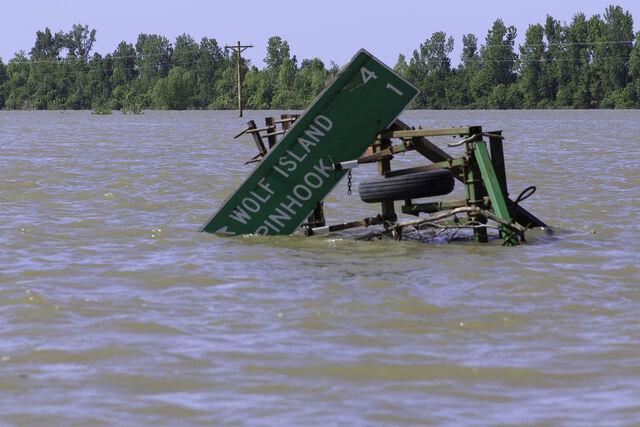Pinhook, Missouri (1927-2011): A Black Ghost Town
Pinhook, Missouri, a small town situated approximately 8 miles west of the Mississippi River, holds a significant place in history as a black community founded by sharecroppers in 1927. Due to limited options for settlement from white landowners refusing to sell their land, these determined individuals settled in low-lying land that would later prove perilous during flood seasons. (Location on our Ghost Towns Map)
The status of Pinhook is both a story of ongoing climate change as well as the lackluster emergency response from the government, who in fact made Pinhook's perilous situation even worse.
 |
| Image: Steve Zumwalt/FEMA via Vox Magazine. |
Five years after its foundation, the Army Corps of Engineers built the Birds Point-New Madrid Floodway to ease the annual flooding along the Mississippi River, in an attempt to save the then-prosperous City of Cairo downstream. The floodway, when used, put the excess waters directly in the path of the town. (ProPublica).
At its peak, the tiny village housed about 250 people in the 1960's, but a series of floods in the 1970's would put the village in significant decline, and the population had fallen to less than 50 by 2010.
The towns fate would be completely sealed in 2011, when historic flooding along the Mississippi River threatened Cairo once again. After the river reached 61.7 feet and sand boils began to develop along the Cairo levees, the decision was made to open the floodways for the first time since 1937.
 |
| Jan 30, 1937 --- "Ohio (River) Flood Level Far Above Cairo Streets" --- Water is within three feet of top of levee protecting Illinois city as expected crest of 62 feet is awaited. Associated Press |
Residents of wealthier communities in the floodway sued, but with levees on the verge of collapse, the floodways were opened. Pinhook residents were given very little advance warning, and soon the village was under fifteen feet of water.
 |
| "A home in Pinhook, Missouri. When the Army Corps opened the floodway, the town was destroyed and its residents have struggled to recover. (Darren Hauck for Reveal News)" [ProPublica] |
The aftermath of the flood brought further devastation to Pinhook. Residents received no assistance for relocation or emergency aid, and any remaining structures fell victim to looting. After over a decade, only 9 individuals ever received any kind of funds for disaster relief. Eventually, the residents were forced to seek refuge in nearby Sikeston, leading to the abandonment of the village. Pinhook became one of the more recent examples of a ghost town, with the last remaining building demolished in 2015. It stands as one of several predominantly African-American ghost towns in Missouri.
 |
| Rubble seen through the doorway of what was once a church in Pinhook. Ryan Schuessler (Al-Jazeera) |
Pinhook can be considered a textbook example of environmental racism, as it is a community that should never had existed where it was, and was put in harms way specifically to protect more prosperous areas near it. Pinhook's story resonates not only as a tale of loss but also as a call to address the vulnerabilities faced by marginalized communities during natural disasters, especially as these events are likely to increase in intensity, scope and frequency as the planet warms.
The plight of the ghost town highlights the pressing need for equitable emergency management strategies, comprehensive disaster relief efforts, and proactive measures to mitigate the impacts of climate change. By learning from the past, we can strive to create a future where no community is left behind or forgotten, and where resilience and support are extended to all.
Thanks as always for reading!



Comments
Post a Comment